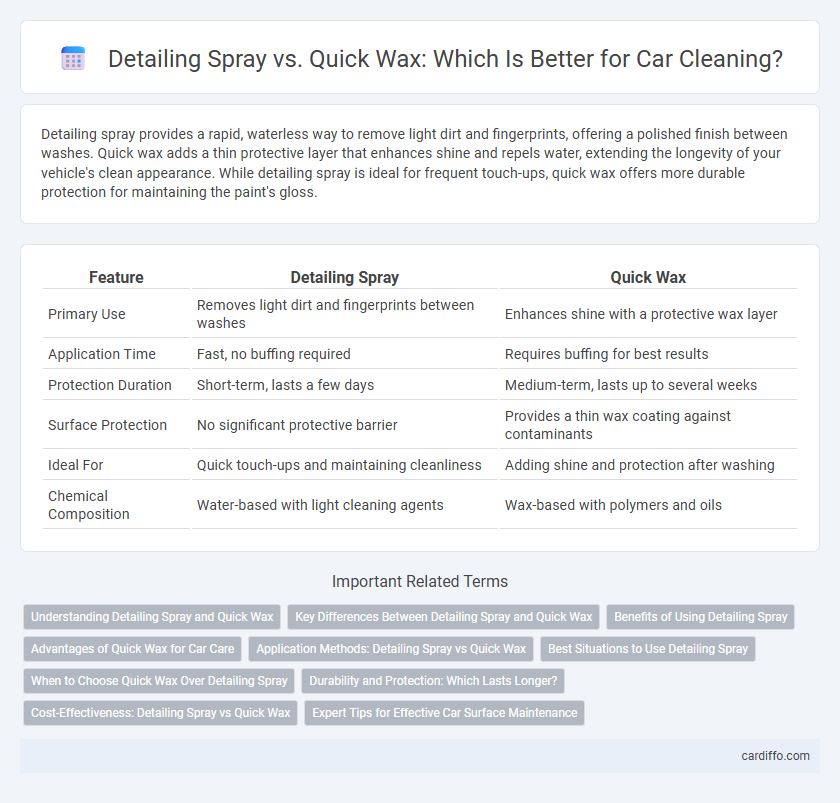Detailing spray provides a rapid, waterless way to remove light dirt and fingerprints, offering a polished finish between washes. Quick wax adds a thin protective layer that enhances shine and repels water, extending the longevity of your vehicle's clean appearance. While detailing spray is ideal for frequent touch-ups, quick wax offers more durable protection for maintaining the paint's gloss.
Table of Comparison
| Feature | Detailing Spray | Quick Wax |
|---|---|---|
| Primary Use | Removes light dirt and fingerprints between washes | Enhances shine with a protective wax layer |
| Application Time | Fast, no buffing required | Requires buffing for best results |
| Protection Duration | Short-term, lasts a few days | Medium-term, lasts up to several weeks |
| Surface Protection | No significant protective barrier | Provides a thin wax coating against contaminants |
| Ideal For | Quick touch-ups and maintaining cleanliness | Adding shine and protection after washing |
| Chemical Composition | Water-based with light cleaning agents | Wax-based with polymers and oils |
Understanding Detailing Spray and Quick Wax
Detailing spray is a water-based formula designed to remove light dust, fingerprints, and smudges while enhancing gloss without the need for a full wash. Quick wax contains carnauba or synthetic waxes that provide a protective layer and add a durable shine, improving paint longevity and water beading. Both products serve different roles in vehicle maintenance, with detailing spray ideal for light touch-ups and quick wax for short-term protection and enhanced depth of color.
Key Differences Between Detailing Spray and Quick Wax
Detailing spray offers lightweight cleaning and water spot removal with a clear, streak-free finish, ideal for routine touch-ups between washes. Quick wax provides a protective layer of wax that enhances shine and repels water and contaminants for longer-lasting protection. While detailing spray primarily focuses on cleaning and shine maintenance, quick wax emphasizes durable surface protection and deeper gloss enhancement.
Benefits of Using Detailing Spray
Detailing spray provides a convenient and effective solution for enhancing vehicle shine without the need for extensive cleanup, allowing quick removal of dust, fingerprints, and light dirt. It enhances the paint's gloss and offers temporary protection between washes, ensuring the surface stays cleaner longer compared to quick wax. Its lightweight formulation is ideal for touch-ups, maintaining a freshly cleaned appearance with minimal effort.
Advantages of Quick Wax for Car Care
Quick wax offers superior long-lasting protection by forming a durable, hydrophobic barrier that repels water and dirt, preserving the car's paint finish. It enhances gloss and depth more effectively than detailing spray, providing a showroom shine that resists environmental contaminants. Quick wax also fills minor scratches and swirl marks, improving surface smoothness and overall aesthetic appeal while requiring less frequent application.
Application Methods: Detailing Spray vs Quick Wax
Detailing spray is applied using a microfiber cloth or spray bottle, allowing for quick and precise cleaning of surface contaminants without rinsing. Quick wax requires a foam applicator pad or microfiber cloth to spread evenly, providing a protective wax layer that enhances shine and durability. Both methods rely on gentle, circular motions to ensure thorough coverage while preventing swirl marks.
Best Situations to Use Detailing Spray
Detailing spray excels in removing light dust, fingerprints, and water spots between washes, making it ideal for quick touch-ups on clean vehicles. It enhances shine and provides a smooth finish without the waxy buildup associated with quick wax products. Use detailing spray when you need a fast, easy way to maintain a freshly cleaned appearance without sacrificing a high-gloss finish.
When to Choose Quick Wax Over Detailing Spray
Quick wax is ideal when a vehicle needs a longer-lasting protective layer after a thorough wash, providing enhanced shine and shield against environmental elements. It is best chosen for slightly dirty or clean surfaces requiring a deeper gloss and durability beyond the temporary shine offered by detailing sprays. Quick wax is preferable for weekend car enthusiasts aiming for extended protection between washes, while detailing sprays suit daily touch-ups or light dust removal.
Durability and Protection: Which Lasts Longer?
Detailing spray offers light, short-term protection by enhancing shine and repelling dust for a few days, ideal for quick touch-ups. Quick wax provides a thicker protective layer, extending durability up to several weeks by sealing the paint and shielding against UV rays and contaminants. For lasting protection and durability, quick wax outperforms detailing spray by maintaining a stronger barrier on the vehicle's surface.
Cost-Effectiveness: Detailing Spray vs Quick Wax
Detailing spray offers a more cost-effective solution for maintaining vehicle shine between washes due to its quick application and minimal product usage. Quick wax, while more expensive per use, provides longer-lasting protection and deeper gloss, reducing the frequency of reapplication over time. Both options save time compared to full waxing, but detailing spray is ideal for budget-conscious car owners seeking immediate shine enhancement.
Expert Tips for Effective Car Surface Maintenance
Detailing spray offers a fast and easy way to remove light dust and fingerprints, enhancing shine without the need for a full wash. Quick wax provides a thin protective layer that seals the paint and adds lasting gloss, making it ideal for maintaining the car's finish between washes. Experts recommend using detailing spray for daily touch-ups and quick wax for bi-weekly protection to optimize car surface maintenance.
Detailing spray vs Quick wax Infographic

 cardiffo.com
cardiffo.com